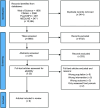The impact of food aid interventions on food insecurity, diet quality and mental health in households with children in high-income countries: a systematic review
- PMID: 39364557
- PMCID: PMC11504351
- DOI: 10.1017/S1368980024001769
The impact of food aid interventions on food insecurity, diet quality and mental health in households with children in high-income countries: a systematic review
Abstract
Objective: Households with children accessing food aid in high-income countries are often food insecure. We aimed to review the evidence on food aid interventions in households with children and impact on food insecurity, diet quality and mental health.
Design: A systematic search was conducted using Web of Science, MEDLINE, CINAHL and PsycINFO. Articles published from January 2008 to July 2022 including cross-sectional, cohort and interventional studies in high-income countries were eligible.
Setting: Food aid is defined as the use of interventions providing free food items by community and/or charitable organisations.
Participants: Two-parent, lone parent or households with a primary caregiver with at least one child ≤ 18 years.
Results: From a total of 10 394 articles, nine were included. Food banks, mobile pantry combined with a free meal for children, backpack provision during school term and food parcel home delivery interventions were evaluated. Food bank models offering additional support such as community programmes, health and social services, cooking classes and free meals for children, client-choice-based models and programmes providing convenient access were associated with improved food security and diet quality (increased intake of wholegrains, fruit and vegetables). One study reported an improvement in mental health and food bank access at the end of 18 months but not at earlier timepoints and one study reported no change in parents' mental health.
Conclusions: Accessing food aid was linked to improved diet quality and reduced food insecurity in some studies. Allowing clients to choose food items and providing support services were most effective.
Keywords: Diet quality; Food bank; Food insecurity; Food pantry; Households with children.
Conflict of interest statement
There are no conflicts of interest.
Figures
Similar articles
-
A mixed methods study exploring food insecurity and diet quality in households accessing food clubs in England.BMC Public Health. 2025 Mar 27;25(1):1156. doi: 10.1186/s12889-025-22353-8. BMC Public Health. 2025. PMID: 40148821 Free PMC article.
-
Diet Quality and Fruit, Vegetable, and Sugar-Sweetened Beverage Consumption by Household Food Insecurity among 8- to 12-Year-Old Children during Summer Months.J Acad Nutr Diet. 2019 Oct;119(10):1695-1702. doi: 10.1016/j.jand.2019.03.004. Epub 2019 May 2. J Acad Nutr Diet. 2019. PMID: 31056369 Free PMC article.
-
Applying the Healthy Eating Index-2015 in a Sample of Choice-Based Minnesota Food Pantries to Test Associations Between Food Pantry Inventory, Client Food Selection, and Client Diet.J Acad Nutr Diet. 2021 Nov;121(11):2242-2250. doi: 10.1016/j.jand.2021.05.007. Epub 2021 Jun 5. J Acad Nutr Diet. 2021. PMID: 34103273 Free PMC article.
-
The COVID-19 pandemic and food insecurity in households with children: A systematic review.PLoS One. 2024 Aug 8;19(8):e0308699. doi: 10.1371/journal.pone.0308699. eCollection 2024. PLoS One. 2024. PMID: 39116160 Free PMC article.
-
Community-level interventions for improving access to food in low- and middle-income countries.Cochrane Database Syst Rev. 2020 Aug 5;8(8):CD011504. doi: 10.1002/14651858.CD011504.pub3. Cochrane Database Syst Rev. 2020. PMID: 32761615 Free PMC article.
Cited by
-
A mixed methods study exploring food insecurity and diet quality in households accessing food clubs in England.BMC Public Health. 2025 Mar 27;25(1):1156. doi: 10.1186/s12889-025-22353-8. BMC Public Health. 2025. PMID: 40148821 Free PMC article.
-
Systematic and Narrative Review of the Mediating Role of Personal Relationships Between Mental Health and Nutrition.Nutrients. 2025 Jul 14;17(14):2318. doi: 10.3390/nu17142318. Nutrients. 2025. PMID: 40732943 Free PMC article. Review.
References
-
- Department for Environment Food and Rural Affairs (2021) UK Food Security Report 2021. https://assets.publishing.service.gov.uk/government/uploads/system/uploa... (accessed 01 September 2022).
-
- Department for Work and Pensions (2023) Family Resources Survey: Financial Year 2021 to 2022. https://www.gov.uk/government/statistics/family-resources-survey-financi... (accessed 11 May 2023).
-
- United States Department of Agriculture Economic Research Service (2023) Food Security in the U.S. https://www.ers.usda.gov/topics/food-nutrition-assistance/food-security-... (accessed 28 September 2023).
-
- Government of Canada (2023) Statistics Canada, Food Insecurity. https://www150.statcan.gc.ca/t1/tbl1/en/tv.action?pid=1310083501 (accessed 28 September 2023).
-
- The Food Foundation (2023) Food Insecurity Tracking. https://foodfoundation.org.uk/initiatives/food-insecurity-tracking (accessed 28 September 2023).
Publication types
MeSH terms
LinkOut - more resources
Full Text Sources
Medical


